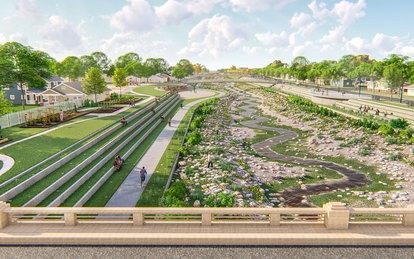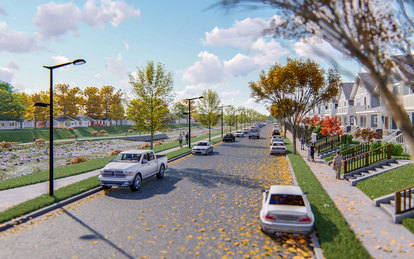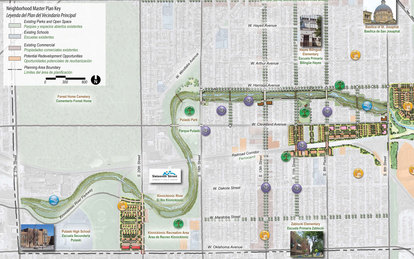Kinnickinnic River Corridor Neighborhood Plan
Transforming an urban river corridor is as much about revitalizing the community around it as it is about restoring the river and managing flood waters.
Client
Milwaukee Metropolitan Sewerage District and Sixteenth Street Community Health Center
Location
Milwaukee, Wisconsin
Markets/Services
Civil Engineering, Landscape Architecture, Sustainable Design, Urban Design, Urban Environments, Urban Planning, Waterfront
Size
2.5 MI
One of Milwaukee’s three intersecting rivers, the Kinnickinnic River, was once a tree-lined stream with natural springs, fishing holes, and abundant wildlife before being channelized with concrete in the early 1960s. Referred to as Milwaukee’s “lost river”, it became a graffiti-covered drainage ditch that was inhospitable to wildlife and dangerous for people in nearby neighborhoods.
Flood management is a big issue for the KK River, as it’s known locally; the river stretches 9.6 miles with a watershed that covers 25 square miles of drainage area and is the most urbanized watershed in the state. More than 660 homes and businesses remain in the floodplain, and roughly 145,000 people live in the watershed.
In 2010, the Milwaukee Metropolitan Sewerage District (MMSD), the agency that maintains the watercourse, knew that something must be done to revitalize the river. Flooding on the KK River had become more hazardous and sewer backups were causing health and safety concerns in the dense neighborhoods near the river. Partnering with the Sixteenth Street Community Health Center, MMSD hired SmithGroup to engage the community around ways to revitalize the river while identifying improvements that would benefit the residents.
SmithGroup’s neighborhood plan resulted from a highly engaging process in the diverse community, including outreach efforts in both Spanish and English. The plan envisions an ecological greenway that provides habitat for wildlife, draws people in for recreational activities, and acts as a generator of new economic opportunities for local businesses and entrepreneurs. Our plan incorporates a major rebuild of the river corridor, removing the concrete lining and widening it to safely convey flood waters and provide more green open space, trails, and access.
We were especially pleased that the process recognized the primary role of residents. We were impressed by the extensive outreach to residents through churches, schools, direct mail and canvassing, and the commitment to meet people where they were in either English or Spanish.
Steve Fendt
Executive Director, Southside Organizing Committee
Upon recommendation by the plan, MMSD acquired about 80 residences for removal in the densest stretch of the river to allow the riverbanks to be widened and laid back. The newly vacant land provided opportunity for community gardens, stormwater management and green infrastructure, open space improvements, mixed-use paths, and economic development in the established neighborhood.


